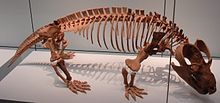Probainognathia
| Probainognathia Temporal range:
| |
|---|---|

| |
| Fossil of the probainognathian Chiniquodon theotonicus in the Staatliches Museum für Naturkunde Stuttgart | |
| Scientific classification | |
| Kingdom: | Animalia |
| Phylum: | Chordata |
| Clade: | Synapsida |
| Clade: | Therapsida |
| Clade: | Cynodontia |
| Clade: | Eucynodontia |
| Clade: | Probainognathia Hopson, 1990 |
| Subgroups | |
Probainognathia is one of the two major subgroups of the clade Eucynodontia, the other being Cynognathia. The earliest forms were carnivorous and insectivorous, though some groups eventually also evolved herbivorous diets. The earliest and most basal probainognathian is the Middle Triassic (Anisian) aged Lumkuia, from South Africa, though probainognathians would not become prominent until the mid Norian stage of the Late Triassic.[2] Three groups survived the extinction at the end of Triassic: Tritheledontidae and Tritylodontidae, which both survived until the Jurassic—the latter even into the Cretaceous (Montirictus and Xenocretosuchus)—and Mammaliaformes, which includes the mammals.[3]
Phylogeny[]

Below is a cladogram from Ruta, Botha-Brink, Mitchell and Benton (2013) showing one hypothesis of cynodont relationships:[4]
| Eucynodontia |
| ||||||||||||||||||||||||||||||||||||||||||||||||||||||||||||||||||||||||||||||||||||||||||||||||||||||||||||||||||||||||||||||
See also[]
- Evolution of mammals
- List of prehistoric mammals
References[]
- ^ Martinelli, A.; Soares, M. B.; Oliveira, T.; Rodrigues, P.; Schultz, C. (2017). "The Triassic eucynodont Candelariodon barberenai revisited and the early diversity of stem prozostrodontians". Acta Palaeontologica Polonica. 62. doi:10.4202/app.00344.2017.
- ^ Abdala, Fernando; Gaetano, Leandro C. (2018), Tanner, Lawrence H. (ed.), "The Late Triassic Record of Cynodonts: Time of Innovations in the Mammalian Lineage", The Late Triassic World, Cham: Springer International Publishing, vol. 46, pp. 407–445, doi:10.1007/978-3-319-68009-5_11, ISBN 978-3-319-68008-8, retrieved 2021-05-24
- ^ The slow and fast steps to becoming a mammal
- ^ Ruta, M.; Botha-Brink, J.; Mitchell, S. A.; Benton, M. J. (2013). "The radiation of cynodonts and the ground plan of mammalian morphological diversity". Proceedings of the Royal Society B: Biological Sciences. 280 (1769): 20131865. doi:10.1098/rspb.2013.1865. PMC 3768321. PMID 23986112.
- Probainognathians
- Extant Middle Triassic first appearances
- Taxa named by James Hopson







